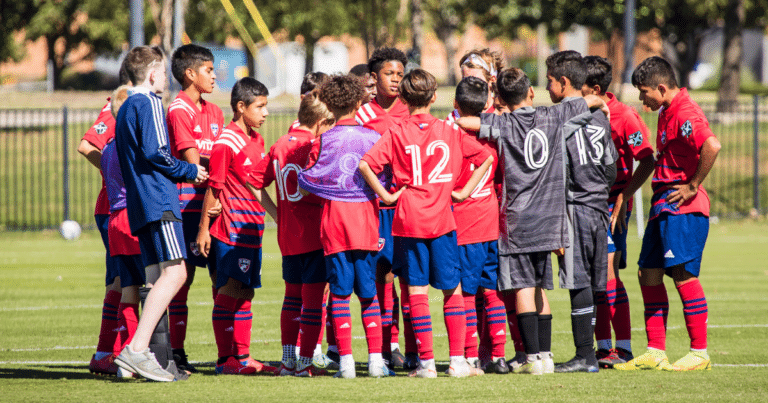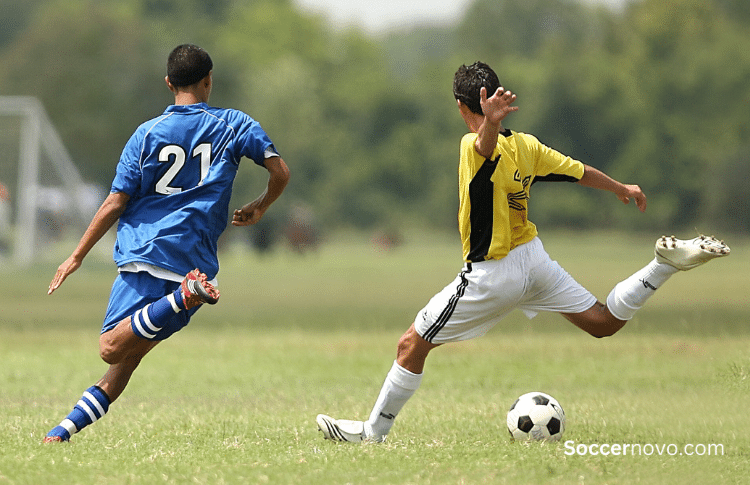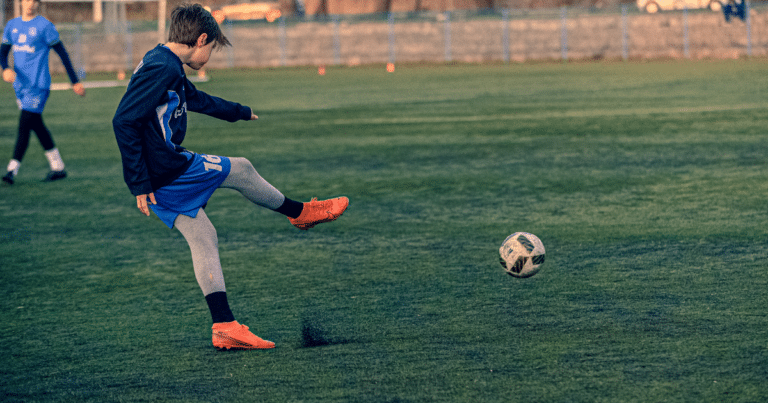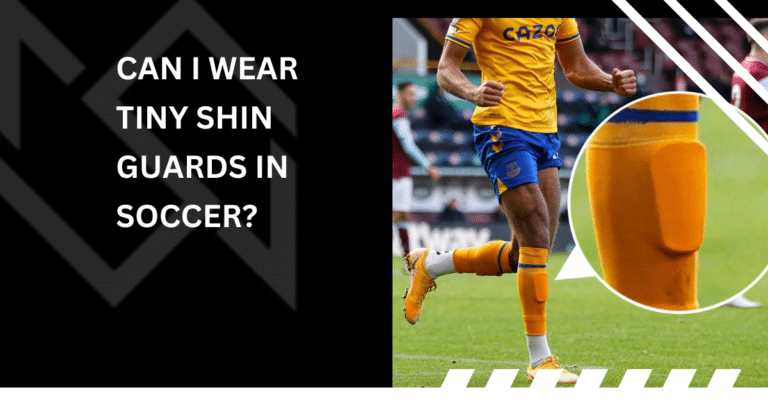How to Defend a Free Kick in Soccer

Learning how to defend a free kick is a lost art in soccer. With the right strategy and techniques teams can put themselves in a better position to prevent a goal.
One of the most important aspects of defending a free kick is setting up a strong defensive wall. The wall should be positioned in front of the goal, with players standing shoulder-to-shoulder and facing the kicker.

Another key aspect of defending a free kick is marking the opposing team’s players. This means assigning each player on your team to mark a specific player on the opposing team, preventing them from receiving the ball and making a shot.
In this article, we’ll dive deeper into defending a free kick in soccer!
Positioning and Formation of a Free Kick
When defending a free kick, positioning and formation are crucial to ensure that the defending team can effectively block the ball from reaching the goal.
The following sub-sections will explain the different aspects of positioning and formation that are important to consider.
Goalkeeper Positioning
The goalkeeper should stand in the center of the goal, ready to move in any direction to make a save. The goalkeeper should also be aware of the position of the defensive wall and adjust their position accordingly.
The goalie should lead the wall and let them know how many players they want in the wall and where they should be.
Defensive Wall Formation
The defensive wall is formed by a group of players who stand in front of the goalkeeper to block the ball from reaching the goal.
The wall should be positioned to cover the side of the goal that the free kick taker is most likely to aim for.
Typically, the wall is formed by three to five players, depending on the distance from the goal and the angle of the free kick.
Defending Players Positioning
Players should be positioned to cover any potential gaps in the defensive wall and to prevent the attacking team from scoring from a rebound. For example, a team may want a player on the near post to prevent a ball curving in and/or a close rebound from happening.
Defenders should also be prepared to quickly close down the free kick taker to prevent them from taking a shot.
Anticipating the Free Kick in Soccer
Anticipating the kick means reading the opponent and predicting the kick direction. By doing so, you can position yourself in the best possible way to block the shot or intercept the ball.
Reading the Opponent
One of the most important aspects of anticipating a free kick is reading the opponent. Pay close attention to their body language and eyes, as it can give you a clue as to where they might aim the ball.
Look for any tell-tale signs, such as the direction they are facing, their foot placement, or the way they are standing over the ball.
Another key factor to consider is the opponent’s preferred kicking foot. If the player is right-footed, they are more likely to aim to the left side of the goal, while left-footed players will typically aim to the right. Knowing these minor details can help you position yourself accordingly.
Predicting the Kick Direction
Once you have read the opponent, the next step is to predict the kick direction. This can be done by analyzing the positioning of the players on the field and the angle of the free kick.
If the opponent has a clear shot at the goal, they will likely aim for one of the corners. However, if there are players in the way, they may opt for a more central shot. Look for any gaps in the defensive wall, as this can give you an idea of where the opponent might aim.
It’s also important to consider the angle of the free kick. If the kick is taken from the left side of the field, the opponent is more likely to aim for the far right side of the goal. Similarly, if the kick is taken from the right side of the field, they will likely aim for the left side of the goal.
By anticipating the kick and positioning yourself accordingly, you can increase your chances of successfully defending a free kick in soccer.
Defending the Free Kick As it Happens
A well-executed and disciplined defense can prevent the opposing team from scoring a goal. In this section, we will discuss two key ways to defend a free kick: Blocking the Kick and Clearing the Ball.
Blocking the Kick
To block a kick from reaching the goal, you need to form a wall with your teammates between the ball and the goal. The wall should be close enough to the ball to prevent the kicker from taking a direct shot at the goal.
When forming the wall, make sure to position yourself properly. You should stand at a slight angle with your arms close to your body. This will help you to cover more space and reduce the chances of the ball getting past you.
As the kicker approaches the ball, the wall should jump up together to block the trajectory of the ball. Make sure to keep your eyes on the ball and be ready to move quickly if the kicker decides to fake the shot.
Also, you may want to cover your sensitive areas of your body so they don’t experience the impact of the soccer ball!
Clearing the Soccer Ball
Clearing the ball is a great way to get it out of the danger as quickly as possible. The offensive team will have to restart their offense or (better yet) it may start a counter attack for your team.
When the ball is kicked, try to anticipate where it will land and position yourself accordingly. Use your head or feet to clear the ball away from the goal. It is important to clear the ball with enough force and air to ensure that it goes far enough away from the goal to prevent the opposing team from scoring.
Timing is critical when clearing the ball. You need to make sure that you clear the ball before the opposing team can get to it. This requires quick thinking and fast reflexes.
Post-Defense Soccer Strategy
After successfully defending a free kick, it’s either time to reset the defense or attack on offense.
Reorganizing the Defense
Once the free kick has been defended, it’s important to quickly reorganize the defense to prevent any counterattacking opportunities for the opposing team. Here are a few tips to help you reorganize your defense effectively:
- Communicate: Make sure everyone on your team knows their defensive responsibilities and is communicating with each other. This will help you quickly reorganize your defense and prevent any gaps from appearing.
- Drop Back: After defending a free kick, it’s a good idea to drop back and form a solid defensive line. This will make it more difficult for the opposing team to break through and create scoring opportunities.
- Stay Alert: Even after successfully defending a free kick, it’s important to stay alert and focused. The opposing team may try to take advantage of any lapses in concentration, so make sure you’re ready to react quickly to any potential threats.
- Cover for teammates: Sometimes a center back has to switch with a left back temporarily…this is okay. In times of a scramble, covering for one another will help fill in potential vulnerabilities.
Counterattacking Opportunities
Defending a free kick can also present opportunities for your team to launch a counterattack and create scoring opportunities. Here are a few things to keep in mind when looking for counterattacking opportunities:
- Quick Transition: After successfully defending a free kick, look to transition quickly and catch the opposing team off guard. This can be a great opportunity to launch a counterattack and create a scoring chance.
- Use the Wings: When launching a counterattack, it’s often a good idea to use the wings to create space and stretch the opposing defense. Look for opportunities to get the ball out wide and create 1v1 situations.
- Be Patient: While it’s important to be quick on the counterattack, it’s also important to be patient and wait for the right opportunity. Don’t force the issue and risk losing possession, instead look for opportunities to create space and exploit any weaknesses in the opposing defense.
Frequently Asked Questions
What is the best way to defend against a wide free kick in soccer?
How do you set up a wall for a free kick in soccer?
What are some common mistakes to avoid when defending a free kick in soccer?

Written By: SoccerNovo
SoccerNovo is an independent youth soccer media brand built to help parents, players, and coaches better understand the game and the pathways available in U.S. soccer. Our mission is to make youth soccer simpler, clearer, and more accessible for everyone involved in it.
Let’s connect






